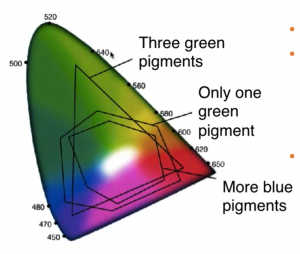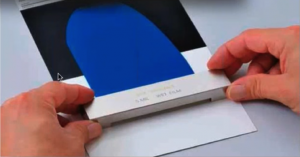How many trial and error steps does it take you to formulate a color? If you answered more than three, it might be time to enlist the help of a computerized solution.
Computer-aided color formulation can bring huge benefits to your business. Out of the gate, even beginners can hit color targets faster, saving time, money and expensive colorants. Once you have established an accurate method, you can expect to match 95% of your color formula requirements within a reasonable color distance on the first try!
When you consider manually mixing color takes an average of 12 tries to get it right, formulation software saves labs a lot of time and money during the development and production phases.
To learn more about the benefits, check out our blog “Fast Formulation is Key to Producing Color of the Year.” Today we are demonstrating how a portable or benchtop spectrophotometer and Color iMatch software can help you formulate paint, plastic, and textile color faster and with less waste.
Steps for Successful Color Formulation
Step One: Choose your colorants.
The amount and type of colorants you choose plays a huge role in the success of your color formulation program. It is important to use clean and bright colorants, and the right amount of each. It is also very important to carefully characterize colorants in the formulation software. You know the saying: “Garbage in, Garbage out!”

Using more colorants will increase the gamut range of achievable colors. This example shows how much larger the gamut becomes when you use three green pigments in your system instead of one.
However, introducing too many pigments is not the right solution either. It will only increase your cost and risk of metamerism. In the end it is all about color theory and balance. As you work with your computer-aided system, you will gain the knowledge to make the best colorant choices to achieve fast and accurate color formulation matches.
Step Two: Prepare your mixes and make drawdowns.
To use a color matching solution, you have to tell the software what the colorants look like. This means entering the Max Tone – the maximum colorant load vs. your resin or base material – and the solutions. For this example, I am using a 5% red with 95% clear base with a 2.5%, a 1%, and a 0.1% mix.
You must also determine the opacity by applying the mixes to white and black contrast cards and using the spectrophotometer to measure them. You can obtain this color data through the contrast ratio method in Color iMatch.

Step Three: Measure the drawdowns into Color iMatch.
Next, you need to measure the drawdowns into the software and create the colorants. Here’s a screen image of how this looks in Color iMatch.

-
This is the selection of colorants already on file.
-
This is the colorant editor with the colorants listed at the top, and the base or resin materials at the bottom.
-
Here are the formulation mixes for a single colorant.
-
And here is the colorant premix for one specific ink. Since the software knows the real scaled amounts, the measurement over light, and the measurement over dark, it can determine and characterize the concentration with its optical property.
Step Four: Match color with the click of a button.
Once the colorant file is ready, you can match a color shade with the click of a button.

-
The colorants are listed here in the Colorants pane. Here you can select a combination of colorants to use, or choose to use them all.
-
You can choose a specific base or have the software choose the most appropriate one. You can also define opacity to run to a target or run on a fully opaque layer, which means full hiding over the black area.
-
Click “Formulate” and Color iMatch will suggest a recipe calculation to achieve the desired level of color within seconds.
-
In this example, combining 97% clear neutral base, 2.78 of white pigment, a little black pigment, some yellow oxide and some exterior red created a predicted Delta E color distance of 0.02.
Step 5: Prepare the mix from the calculated formula.

It’s time to test the results. Prepare a mix and drawdown from the calculated formula and measure the color into the software. Often the first attempt is close enough. If not, you can address issues and further adjust and enhance the match by running a shade correction with just a click of a button.
Many of our customers choose to automate their dispensing processes with remote connectivity. Color iMatch is quite flexible in interacting with these systems and can transmit color formula data automatically; even to production scale dispensing machines.
The system is only as accurate as your overall process.
-
It is very important, so I will say it again… the software is only as good as the original pigment calibration data. If you don’t take the time to do this right, you cannot expect good color formula results.
-
Consider variations in colorant batches, which can be controlled by colorant strength assessments.
-
Keep your contrast cards stable and clean, and replace them regularly.
-
Use an accurate scale and write down the exact measured amounts to the last decimal point.
-
Note that sample thickness influences shade and appearance, especially for translucent paints.
-
Non-homogenous samples, dirt, scratches, and varying surface conditions all have an effect on the color results, so be as consistent as possible.
-
For the highest performing color formulations, your entire production method must be reproducible. Make sure everyone is following the same procedures.
Controlling your pigment or colorant batch quality is essential.
This image shows the physical condition of the same pigments along with a microscopic image of the particles. The smaller ground pigment particles have an overall surface area that is much higher than the rough pigments. Notice the impact this has on the pigment’s appearance? You can address this through colorant strength control, something we can teach you how to do.
The Return on Investment is Amazing!
Try our Color iMatch ROI calculator to see how much you can save. Believe it or not, 90% of X-Rite customers confirm ROI within 12 months after installing a computer-aided color formulation system.
If Color iMatch sounds like an investment you might be ready to make, get in touch to speak with our Color Experts.
Color iMatch Specs
-
Color Differences
FMCII, CIE DL*, Da*, Db*, CIE DL*, DC*, DH*, Hunter DL, Da, Db, All Attributes of CIELab, CIELch or HunterLab, CMC (l:c), CIE2000 (l:c:h)
-
Color Spaces
CIE L*a*b*, CIE L*C*h*, Hunter Lab, CIE (XYZxy)
-
Databases
MS Access, MS SQL Server
-
Illuminants
D50, D55, D65, D75, F2, F7, F11, C, A, Horizon, TL84, Ultralume 3000
-
Languages Supported
English, French, German, Spanish, Italian, Portuguese, Japanese, Chinese
-
Measurement Conditions
Reflectance, Tranmission, Reflectance / Transmission, Over Light / Over Dark, SCI / SCE
-
Observers
2 degree, 10 degree
-
Supported Devices
eXact, eXact Scan, eXact XP, CI4200, CI52, CI62, CI64, 962, 964, Color i5, Color i7, CE-7000A, CI7600, CI7800, SP62, SP64
For additional specs, visit the Color iMatch product page.
